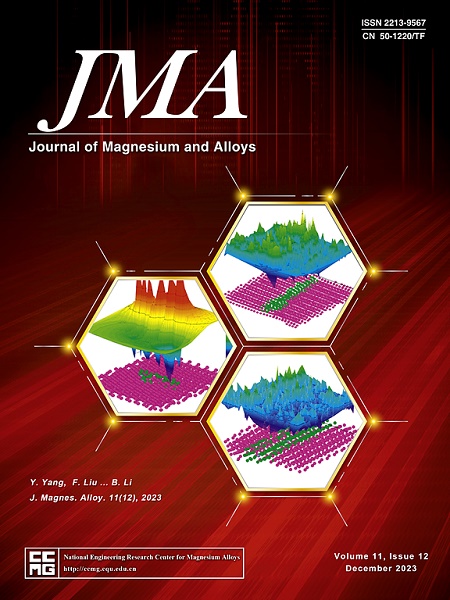探索高强度、高耐腐蚀的低合金挤压镁合金
IF 13.8
1区 材料科学
Q1 METALLURGY & METALLURGICAL ENGINEERING
引用次数: 0
摘要
强度与耐蚀性之间的权衡制约了低合金镁合金的发展。采用简单的常规铸造工艺和适当的热挤压工艺制备了低合金Mg-1Sm-0.8Mn-0.5Ca-0.4 Zn合金。挤压态合金的屈服强度高达402 MPa,伸长率为5%,腐蚀速率为0.56 mm y-1,接近高纯Mg合金,这些综合性能优于大多数已报道的镁合金,无论是高合金化还是低合金化。特殊的精细组织是高强度的原因,包括细小的动态再结晶(DRXed)晶粒、强织构的非DRXed晶粒、位错和均匀分散的纳米间距α-Mn纳米析出相。本研究的一个重要发现是腐蚀膜微观结构具有非晶态特征,这必然有助于膜的高防护性,最终提高了微电腐蚀倾向较强的挤压态合金的耐蚀性。此外,还讨论了具有阳极性质的微/亚微米Mg2Ca和具有强强化作用的纳米级阴极α-Mn析出物对腐蚀膜的影响。本研究表明,通过调节低合金镁合金基体和腐蚀膜的组织,可以避免强度-腐蚀权衡。本文章由计算机程序翻译,如有差异,请以英文原文为准。

Exploring low-alloyed as-extruded Mg alloy with high strength and high corrosion resistance
The tradeoff between strength and corrosion resistance restricts the development of low-alloyed magnesium (Mg) alloys. In this work, a low-alloyed Mg-1Sm-0.8Mn-0.5Ca-0.4 Zn alloy was prepared through a simple process of conventional casting followed by proper hot-extrusion. The as-extruded alloy exhibits a very high yield strength of 402 MPa, an acceptable elongation of 5 %, and a low corrosion rate of 0.56 mm y-1 which is close to that of high-purity Mg, and such comprehensive properties are superior to most reported Mg alloys, whether high alloying or low alloying. The special fine microstructure is responsible for high strength, including fine dynamic recrystallized (DRXed) grains, strong textured un-DRXed grains, dislocations and uniformly dispersed nano-spaced α-Mn nano-precipitates. An important finding of this study is that the corrosion film microstructure has amorphous characteristics, and this inevitably contributes to the high film protectiveness, and finally improves the corrosion resistance of the as-extruded alloy with relatively strong micro-galvanic corrosion tendency. In addition, the influence of micro/submicron-sized Mg2Ca with anodic nature and nano-sized cathode α-Mn precipitates with strong strengthening effect on the corrosion film is also discussed. This study suggests that the strength-corrosion tradeoff can be evaded by regulating the microstructure of alloy substrate and corrosion film in the low-alloyed Mg alloy.
求助全文
通过发布文献求助,成功后即可免费获取论文全文。
去求助
来源期刊

Journal of Magnesium and Alloys
Engineering-Mechanics of Materials
CiteScore
20.20
自引率
14.80%
发文量
52
审稿时长
59 days
期刊介绍:
The Journal of Magnesium and Alloys serves as a global platform for both theoretical and experimental studies in magnesium science and engineering. It welcomes submissions investigating various scientific and engineering factors impacting the metallurgy, processing, microstructure, properties, and applications of magnesium and alloys. The journal covers all aspects of magnesium and alloy research, including raw materials, alloy casting, extrusion and deformation, corrosion and surface treatment, joining and machining, simulation and modeling, microstructure evolution and mechanical properties, new alloy development, magnesium-based composites, bio-materials and energy materials, applications, and recycling.
 求助内容:
求助内容: 应助结果提醒方式:
应助结果提醒方式:


